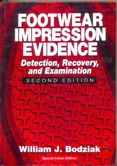
|
FOOTWEAR IMPRESSION EVIDENCE,2ND ED ,INDIAN REPRINT 2012 - WILLIAM J. BODZIAK (EX) |
Author |
WILLIAM J. BODZIAK
|
|
Cover Price : Rs 3,995.00
|
Imprint : CRC Press
ISBN : 9780849310454
YOP : 2012
|
Binding : Hardbound
Total Pages : 520
CD : No
|
|
Reviewed and recognized as the most authoritative source in the field, this comprehensive work describes the methods used worldwide to recover and identify footwear impressions from the scene of a crime.
In this new edition, the original twelve chapters, bibliography, appendix, etc., has been clarified, updated and expanded. This edition includes updated and new information on recovery procedures and materials such as lifting, photography and casting; chemical enhancement; updated information about footwear manufacturing; footwear sizing; and known impression techniques and materials.
WHAT’S NEW IN THE SECOND EDITION:
Besides updating and expanding the twelve original chapters, Footwear Impression Evidence: Detection, Recovery and Examination, Second Edition adds three new chapters: one chapter on barefoot evidence, which concerns impressions made by the naked or sock-clad foot or those which remain in abandoned or discarded footwear; another new chapter on several cases in which the footwear impression evidence was of primary importance in bringing about a conviction or confession; and finally, a new chapter on the footwear impression evidence in the O.J. Simpson criminal and civil cases.
Contents
AWARENESS, DETECTION AND TREATMENT OF FOOTWEAR IMPRESSION EVIDENCE
General Information Regarding Footwear Impression Evidence
Formation of Footwear Impression
Finding Footwear Impressions at the Scene of the Crime
General Treatment of Impressions
PHOTOGRAPHY OF FOOTWEAR IMPRESSIONS
General Crime Scene Photography
Examination Quality Photography
Checklist for Examination Quality Photography
CASTING THREE-DIMENSIONAL FOOTWEAR IMPRESSIONS
Introduction to Casting
Casting Materials
Methods of Casting with Dental Stone
After the Cast is Poured
Casting Footwear Impressions in Snow
The Importance of Casting All Three-Dimensional Impressions
TREATMENT OF TWO-DIMENSIONAL FOOTWEAR IMPRESSIONS
Lifting Two-Dimensional Footwear Impressions
Lifting Impressions Electrostatically
Gelatin and Adhesive Lifting
Other Lifting Materials and Choices
Impressions That are Difficult to Lift
Powdering Impressions
Selection of Proper Lifting Materials
Deformable Impressions
THE ENHANCEMENT OF FOOTWEAR IMPRESSIONS
Specialized Lighting and Forensic Photographic Methods
Physical Methods
Chemical Enhancement
Chemical Methods for Enhancement of Residue Impressions
Chemical Methods for Enhancement of Footwear Impressions in Blood
Sequencing of Enhancement Techniques
Three-Dimensional Impression Enhancement
Use of Computers
FOOTWEAR SIZING
Shoe Sizing and Shoe Sizing Systems
Forensic Considerations
MANUFACTURING PROCESSES OF SYNTHETIC SOLED SHOES
The Footwear Industry
The Molding Process
Molding Processes
The Cut Processes
Recognition of Manufacturing Methods
Some Reasons for Shoes of One Size and Design Varying
KNOWN SHOES OF SUSPECTS AND THE PREPARATION OF KNOWN IMPRESSIONS
Obtaining the Known Shoes From the Suspect
Footwear Databases
Test Impressions of Known Shoes
Summary
WEAR CHARACTERISTICS
Defining Wear Characteristics
Factors Influencing the Wear of Shoe Outsoles
Considerations of Wear Characteristics During Examination
CLASS AND IDENTIFYING CHARACTERISTICS
Class Characteristics
Identifying Characteristics
Characteristics Required for Positive Identification
Changes in Identifying Characteristics as Shoe Wear Continues
COMPARISON OF THE QUESTIONED IMPRESSION WITH KNOWN SHOES
Treatment of the Evidence
Variation and Distortion
Examination of the Questioned Impression
Results
THE FOOTWEAR IMPRESSION EXAMINER IN COURT
What Constitutes an Expert Witness?
What Qualifies a Footwear Impression Examiner as an Expert?
PreTrial Conferences
Presentation of Examination Results in Court
Last Minute Examinations
IMPRESSIONS OF THE FOOT
Introduction
Individuality of the Feet
Known Standards of the Feet
The Examination Process
Case Examples
SOME CASE APPLICATIONS
St. Croix Homicide Case
The New York Gap Homicide
Denver Multiple Homicide Case
The Naperville Case
A New York Serial Robbery/Homicide Case
A South Carolina Homicide
THE FOOTWEAR IMPRESSION EVIDENCE IN THE O. J. SIMPSON TRIAL
References
Glossary
Appendix
Index
|
|
 |
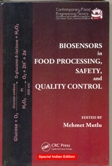
|
BIOSENSORS IN FOOD PROCESSING, SAFETY, AND QUALITY CONTROL, INDIAN REPRINT - MEHMET MUTLU (EX) |
|
|
Cover Price : Rs 3,995.00
|
Imprint : CRC Press
ISBN : 9781439819852
YOP : 2013
|
Binding : Hardbound
Total Pages : 358
CD : No
|
|
Biosensors in Food Processing, Safety, and Quality Control address the latest developments in a fast moving, critical technology and its application in the food industry. The book examines contamination detection in the food chain from the early stages to the processing state. It also explores the opportunities created by chemical and biosensensing technology and recent improvements for better food quality, safety, processing, control, and imput.
In detailed discussions of currently available tools and those that are in development to determine the toxin content in food samples, the book covers:
-Using amperometric biosensors in food processing, safety, and quality control
-Basic optical biosensor systems and their operating principles
-Detection, assay format, and applications of QCM as a mass sensitive immunosensor in food analysis
-Electrochemical DNA biosensor techniques for the detection of food safety and quality
-Application of biosensors in quality control of milk and milk products
-Electrochemical biosensors for the detection of antioxidants in the food and beverage industries
-Successful approaches using neural networks and different types of sensors and biosensors
Because they make the assay easier, quicker, and more accurate, simple alternative methods like biosensors are preferred for quality control. The high sensitivity and selectivity of many biosensors potentially allow the accurate determination of low levels of analytes in complex media, which has led to intensive research and development in the area. Copiously illustrated with figures, tables, charts, and graphs, this book summarizes the past, present, and future of biosensors with an emphasis on food technology, providing direction for future research and applications of the technology.
Contents
Chapter 1 Amperometric Biosensors in Food Processing, Safety, and Quality Control, İsmail Hakkı Boyacı and Mehmet Mutlu
Chapter 2 Basic Principles of Optical Biosensors in Food Engineering, Ebru Akdoğan and Mehmet Mutlu
Chapter 3 Mass Sensitive Biosensors: Principles and Applications in Food, Selma Mutlu
Chapter 4 Biosensing for Food Safety, María Isabel Pividori and Salvador Alegret
Chapter 5 Electrochemical DNA Biosensors in Food Safety, Pınar Kara, Ozan Kılıçkaya, and Mehmet Şengün Özsöz
Chapter 6 Biosensors for the Assessment of Natural Toxins in Food, Beatriz Prieto-Simón, Thierry Noguer, and Mňnica Campŕs
Chapter 7 Biosensors for Pesticides and Foodborne Pathogens, Munna S. Thakur, Raghuraj S. Chouhan, and Aaydha C. Vinayaka
Chapter 8 Impedance Biosensors/Biochips for Detection of Foodborne Pathogens, Liju Yang
Chapter 9 Application of Biosensors for the Quality Assurance of Dairy Products, P. Narender Raju and K. Hanumantha Rao
Chapter 10 Electrochemical Biosensors as a Tool for the Determination of Phenolic Compounds and Antioxidant Capacity in Foods and Beverages, Montserrat Cortina-Puig, Thierry Noguer, Jean-Louis Marty, and Carole Calas-Blanchard
Chapter 11 Neural Networks: Their Role in the Field of Sensors, José S. Torrecilla
Chapter 12 Trends in Biosensing and Biosensors, Frank Davis and Séamus P.J. Higson
Index
|
|
 |
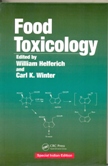
|
FOOD TOXICOLOGY, INDIAN REPRINT - WILLIAM HELFERICH (EX) |
Author |
WILLIAM HELFERICH
CARL K. WINTER
|
|
Cover Price : Rs 2,995.00
|
Imprint : CRC Press
ISBN : 9780849327605
YOP : 2013
|
Binding : Hardbound
Total Pages : 238
CD : No
|
|
New data continually indicate that antioxidants may contribute to reductions in cancer risks and that chronic consumption of low levels of chemical carcinogens in our diet may contribute to an increased risk of developing specific types of cancers. Research also shows that in America today, the leading causes of death are cancer and heart disease. Considering that diet plays a significant role in the development of both of these diseases, issues of food toxicology become particularly topical.
Food Toxicology provides a comprehensive look at contemporary food toxicology issues. Its nine chapters, all authored by leading American academic experts, concisely address critical chemical food safety and food toxicology issues that emerged in the latter half of the last decade. Specifically, the book discusses food allergens and their diagnoses, biotechnology, estrogenic factors, and anti-toxicants. It also addresses more traditional topics such as pesticide residues, food additives, plant toxins,
microbial toxins, and food analysis.
Food Toxicology presents a comprehensive treatment of food toxicology topics of scientific, regulatory, and public interest. In essence, therefore, the book represents an up-to-date analysis of important topics that are found both at the cutting edge of science and on the front pages of newspapers.
Features
• Presents important topics in food safety and toxicology
• Evaluates the relative risk associated with consumption of low levels of pesticides
• Addresses cutting-edge developments of critical importance to the food industry and public health
• Debates the merits of risk evaluation, a particularly important issue to all involved in food toxicology
• Discusses the history of the development and commercialization of genetically modified foods, an issue at the forefront of international trade discussions and one which is clearly of significant interest to consumers
• Discusses the potential risks and benefits of dietary estrogens and antiestrogens, concerns which are likely to form the toxicology issue of the early part of this century
Contents
-Food Allergies and Sensitivities
-Dietary Estrogens and Antiestrogens
-Nonnutrient Antitoxicants in Food
-Safety of Genetically Engineered Foods
-Microbial Toxins in Foods: Algal, Fungal, and Bacterial
-Natural Toxins and Chemopreventives in Plants
-Pesticide Residues in the Food Supply
-Food Additives
-Analysis of Chemical Toxicants and Contaminants in Food
Index
|
|
 |
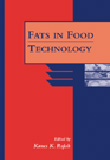
|
Fats in Food Technology - Kanes K Rajah |
|
|
Cover Price : Rs 595.00
|
Imprint : Blackwell Science
ISBN : 1405130598
YOP : 2004
|
Binding : Paperback
Total Pages : 390
CD : No
|
|
DESCRIPTION
This is a book about the roles and behaviour of fats in food technology and the benefits that they impart to consumers. It is about fats that are naturally present in foods (e.g. milk fat in cheese) or fats that have been added to help with physical and chemical properties (e.g. cocoa butter in chocolate). It is a book which has useful information on market issues that have driven change and disciplines that have helped to regulate the trade and use of fats and oils in food technology.
The volume provides a source of concentrated information over a broad subject area and will be especially valuable to those specialising in one sector of the fats industry who are considering expansion into another.
TABLE OF CONTENTS
Physical properties of fats in food
Bakery fats
Water continuous emulsions; Hydro-
genation and fractionation
Fats for chocolate and sugar
confectionery
Spreadable products
Emulsifiers and stabilizers
Role of milkfat in hard and semihard cheeses
Culinary fats: solid and liquid frying oils and speciality oils
Appendix: Nomenclature for fatty acids and triglycerides
References
Index.
|
|
 |
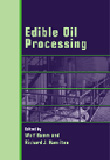
|
Edible Oil Processing - Wolf Hamm |
Author |
Wolf Hamm
Richard P Hamilton
|
|
Cover Price : Rs 595.00
|
Imprint : Blackwell Science
ISBN : 1405130601
YOP : 2004
|
Binding : Paperback
Total Pages : 282
CD : No
|
|
DESCRIPTION
The ability to process oils and fats to make them acceptable as part of our food supplies is a key component in our overall knowledge of them. Without this ability, the food that we consume would be totally different, and much of the flexibility available to us as a result of the application of processing techniques would be lost. Obviously we need to know how to process fatty oils, but we also need to know how best to use them once they have been processed.
This volume presents, at professional and reference level, the current state of the art of the edible oils industry, focusing on the various processing stages and considering issues of both chemistry and process engineering.
It considers the transformation of the oil from a vast panorama of lipids in an oilseed or an oil-bearing fruit to a functional product, highlighting the links between the different stages.
Information is provided on the types and characteristics of oils to be processed, their sources, their principal fields of application and changes in the pattern of oil demand. Chapters are included on quality assurance, safety and environmental considerations.
The book is written for chemists and technologists working in edible oils and fats processing; food scientists and technologists; analytical chemists and quality assurance personnel; and lipid chemists working in academic research laboratories.
TABLE OF CONTENTS
Composition and properties of edible oils; Bulk movement of edible oils; The production of oils; Refining practice; Oil modification processes; Quality control; Applications of edible oils; Safety; Utilities and environmental impact; Refinery location and design; References; Index. |
|
 |
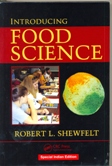
|
INTRODUCING FOOD SCIENCE (INDIAN REPRINT) - ROBERT L. SHEWFELT (EX) |
Author |
ROBERT L. SHEWFELT
|
|
Cover Price : Rs 1,995.00
|
Imprint : CRC Press
ISBN : 9781587160288
YOP : 2013
|
Binding : Hardbound
Total Pages : 386
CD : No
|
|
As daily consumers of foods and beverages, everyone has opinions and interests about their diet choices. However, many questions about food are often non-technical and, therefore, defy technical answers. Introducing Food Science addresses a range of food issues facing today’s consumer, proceeding from a general and student-friendly discussion to an in-depth technical overview of the basic principles of food science.
This authoritative textbook starts by addressing food issues in the news, from disease outbreaks to the health benefits and detriments associated with international trade. It then outlines the basic principles of food manufacturing and processing techniques with a strong emphasis on unit operations. With the aid of flowcharts, photographs, and thought-provoking questions, the book:
Introducing Food Science emphasizes the separation of what is known from what is unknown about food issues and then determines how those issues can be reformulated into testable hypotheses. Unlike other food science references, it conveys both commercial and scientific perspectives, providing a true flavor of food science.
Contents
• FOOD ISSUES IN THE NEWS
Food Safety
Healthiness of Foods
Choosing the Food We Eat
• COMMERCIAL FOOD PRODUCTS
Processed Foods
Formulated Foods
Chilled and Prepared Foods
• FUNCTIONS OF FOOD SCIENTISTS
Quality Assurance
Product and Process Development
Government Regulation and Basic Research
• SCIENTIFIC PRINCIPLES
Food Chemistry
Nutrition
Food Microbiology AND BIOLOGICAL PROPERTIES OF FOODS ..
Food Engineering
Sensory Evaluation
INDEX
|
|
 |
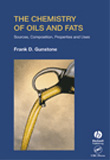
|
The Chemistry of Oils and Fats : Sources, Composition, Properties and Uses - Frank D Gunstone |
|
|
Cover Price : Rs 595.00
|
Imprint : Blackwell Science
ISBN : 1405133309
YOP : 2005
|
Binding : Paperback
Total Pages : 288
CD : No
|
|
DESCRIPTION
The three major macronutrients are proteins, carbohydrates, and lipids (oils and fats). This book is devoted to lipids, which are an important part of life for all of us. What are these materials in molecular terms? Where do they come from? What happens to them between the harvesting of crops and the appearance of the oils and fats in different products in the supermarket? How does nature produce these molecules and can we act on nature to modify the materials to increase their beneficial properties? How important are the minor products present in the fats that we consume? Since oils and fats vary, how can we analyse them? What are their physical, chemical and nutritional properties? How do the fats that we consume affect our health and well-being in both quantitative and qualitative terms? What are their major food and non-food uses?
This book provides a broad source of reference on oils and fats chemistry for graduates entering the food and oleochemical industries, postgraduate researchers and nutritionists. It offers a point of entry to the detailed literature.
CONTENTS
1. Oils and fats: sources and constituents
2. Extraction, refining and processing
3. Structure of fatty acids and lipids
4. Chemical and biological synthesis of fatty acids and lipids
5. Analytical procedures
6. Physical properties
7. Chemical properties related to unsaturated centres
8. Chemical properties related to the carboxyl group
9. Nutritional properties
10. Edible uses of oils and fats
11. Non-edible uses of oils and fats
References
Index.
|
|
 |
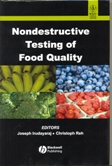
|
NONDESTRUCTIVE TESTING OF FOOD QUALITY - JOSEPH IRUDAYARAJ (EX) |
Author |
JOSEPH IRUDAYARAJ
CHRISTOPH REH
|
|
Cover Price : Rs 3,995.00
|
Imprint : Wiley India
ISBN : 9788126537822
YOP : 2013
|
Binding : Hardbound
Total Pages : 380
CD : No
|
|
Nondestructive food testing is at the forefront of automation efforts to ensure the highest quality of safe foods and the efficient incorporation of new processes. The expert contributors to Nondestructive Testing of Food Quality clearly explain present industry advances and how to turn available instrumentation into valuable assets. Readers learn how the competencies of product knowledge, process understanding, instrumentation, principles of sensing, process control, and analytical methodology are required to turn an application into a successful venture.
The broad-based coverage of topics addresses the most dominant sensor technologies keeping in mind the research initiatives necessary to advance these technologies not only in food but also in the pharmaceutical sectors. Topics include:
• ultrasound
• near-infrared spectroscopy
• mid-infrared spectroscopy
• Raman spectroscopy
• particle characterization
• magnetic resonance imaging
• electronic nose
• z-nose
• biosensors
• capacitance sensors
The book fulfills the crucial need for a practical approach to sensor technology that is useful to food industry engineers and scientists. Research scientists in universities and industry consultants will find the experimental and testing protocols to be practical tools. Nondestructive Testing of Food Quality illustrates how achieving stable measurement conditions and applying corrective actions on the process line are greatly dependent not only on the technology and methods applied, but also on the planning and involvement of professionals with multidisciplinary training, including management.
Contents
1. An Overview of Nondestructive Sensor Technology in Practice: The User's View.
2. The influence of Reference Methods on the Calibration of Indirect Methods.
3. Ultrasound: New Tools for Product Improvement.
4. Use of Near Infrared Spectroscopy in the Food Industry.
5. Application of Mid-infrared Spectroscopy to Food Processing Systems.
6. Applications of Raman Spectroscopy for Food Quality Measurement.
7. Particle Sizing in the Food and Beverage Industry.
8. Online Image Analysis of Particulate Materials.
9. Recent Advances in Nondestructive Testing with Nuclear Magnetic Resonanace.
10. Electronic Nose Applications in the Food Industry.
11. Biosensors: A Theoretical Approach to Understanding Practical Systems.
12. Techniques Based on the Measurement of Electrical Permittivity.
About the Author
Joseph Irudayaraj, PhD, is an associate professor of Agricultural and Biological Engineering at Purdue University, West Lafayette, IN. With over 15 years of research and teaching experience in biological and food engineering, Dr. Irudayaraj has been a faculty member at the University of Saskatchewan, Utah State University, and Penn State. His current role at Purdue is to develop micro and nanosensors for food, health, and environmental applications.
Christoph Reh, PhD, is a research scientist at Nestlé Research Center, Lausanne, Switzerland working on scientific projects for innovative beverage concepts. Prior to his appointment he was involved for more than 10 years in process analytics including non-destructive testing for factory application and physico-chemical characterization of foods. |
|
 |
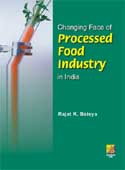
|
Changing Face of Processed Food Industry in India - Rajat K. Baisya |
|
|
Cover Price : Rs 1,495.00
|
Imprint : Ane Books Pvt. Ltd.
ISBN : 9788180521669
YOP : 2019
|
Binding : Hardbound
Total Pages : 336
CD : No
|
|
DESCRIPTION:-
Processed food industry in India has been receiving all kinds of support and attention of the government since last two decades when a separate Ministry of Food Processing was formed with an independent minister being in charge of that. Although this industry has been identified as sunrise sector with huge potential placing emphasis on our agriculture based economy, the food processing sector did not perform. Since the inception of liberalization and open market driven policy from beginning of 1991 the industry suddenly got a new challenge from the global players looking at the market size of India . Local players were not doing well in one hand and had to face the big global players all of a sudden which forced them to view the businesses from different perspectives exploiting other opportunities and alternative models as available to them. And that journey for the local players is still continuing. As a result, the face of our food industry is constantly changing.
These series of articles under the theme “ Changing Face of Processed Food Industry in India” was started about a decade ago and regularly being featured in the magazine “Processed Food Industry”, a leading monthly journal focusing on the happening on this sector and also in other leading journals on food processing industry like Indian Food Packer, Indian Food Industry, Modern Food Industry, Middle East Food and Times Journal of Food Processing etc. The Author has compiled, updated and even modified select articles from the same series appeared in different times in these journals and put the entire series so far published in the form of a book for reference by the numerous professionals ,academicians, researchers, policy makers and others involved in this industry directly or indirectly.
The articles were placed under various section in a chapter corresponding to the sub sectors of the industry category in order to provide a perspective regarding what is happening to that sector due to change in policy as well with the entry and competition from multinationals.
CONTENTS:-
Dedication, Preface, Acknowledgement, 1. Indian Processed Food Industry-Current Status, 2. New Competition from Multinationals in Processed Food, 3. Dairy and Dairy Products, 4. Sugar and Sugar Confectionery, 5. Food Retailing, Service and Fast Food Restaurants, 6. Alcoholic Beverages, 7. Non-Alcoholic Beverages, 8. Bakery, Biscuits and Breakfast Cereals, 9. Meat, Poultry and Marine Products, 10. New Food Products, 11. Constraints, New Initiatives and Opportunities, 12. International Trade Opportunities, 13. Quality, Labeling and Regulatory, 14. Indian Food Industry – Key Challenges. 15. Future of Indian Processed Food Industry, Appendix, Bibliography, Index.
ABOUT THE AUTHOR:-
Prof Rajat Kanti Baisya, a Ph.D ( Engineering) from Jadavpur University, Kolkata is currently a Professor of Marketing & Strategic Management at the Dept. of Management Studies, IIT, Delhi. He has served for over twenty eight years in industry and the last couple of assignments being President &CEO of Emami Group of Companies and Senior Vice President ( Business Development) of Reckitt & Colman of India Ltd and General Manager at Escorts Ltd.Prof Baisya is a member of numerous professional societies including Life member of All India Food Processors Association, Association of Food Scientists & Technologists, Project Management Associates, Consultancy Development Center etc. He is a certified Management Consultant . He is also an editorial board member of Indian Food Packer, Process Food Industry, Beverage & Food World, Journal of Food Science & Technology, Journal of Scientific & Industrial Research, Project Management Today besides many other International journals. He has served / serving on numerous government committees and trade bodies as well as on board of many companies.
Prof Baisya has written over 200 articles and research paper on various aspects of business and industry and presented over 40 conference papers in national and international symposia, In addition, he has authored over 100 articles on Indian food processing industry itself. He is the recipient of many awards including Gardner Award of AFST( I) for 1974, Dr J. S.Pruthi Award for making significant contribution to Processed Food Industry for 2001, Commendation Award for 2002 from National Institute of Management & Technology for significant contribution on industrial turn around strategies.
|
|
 |
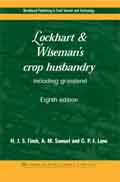
|
Lockhart & Wiseman's crop husbandry : including grassland - H. J. S. Finch |
Author |
H. J. S. Finch
A. M. Samuel
G. P. F. Lane
|
|
Cover Price : Rs 795.00
|
Imprint : Woodhead
ISBN : 1855735491
YOP : 2007
Edition : 2007
|
Binding : Paperback
Total Pages : 528
CD : No
|
|
DESCRIPTION:-
First published in 1966, Lockhart and Wiseman's crop husbandry has established itself as the standard crop husbandry text for students and practitioners alike. Radically revised and expanded, and with a new team of authors, the eighth edition confirms and extends its reputation.
Part 1 looks at the basic conditions for crop growth with chapters on plant structure and growth, soil analysis and management, and the use of fertilisers and manures. There is also a new chapter on the influence of climate and weather.
Part 2 surveys general aspects of crop husbandry. As well as a discussion of cropping techniques, there are new chapters on the important new areas of integrated crop management and organic crop husbandry, as well as discussion of seed selection and production.
Part 3 then looks at how these general techniques are applied to particular crops, with chapters on cereals, root crops, fresh harvested crops, forage crops and combinable break crops.
Part 4 considers the use of grassland with chapters on classification, sowing and management, grazing and conservation for winter feed.
Lockhart and Wiseman's crop husbandry remains the standard text for general agriculture, land management and agri-business courses, and is a valuable practical reference for the farming industry.
CONTENTS:-
Foreword
PART 1 CONDITIONS FOR CROP GROWTH
PART 2 CROP HUSBANDRY TECHNIQUES
PART 3 THE MANAGEMENT OF INDIVIDUAL CROPS
PART 4 GRASSLAND
Appendices
Index.
ABOUT THE AUTHORS:-
Steve Finch is Senior Lecturer in Crop Production at the Royal Agricultural College, Cirencester.
Alison Samuel is Senior Associate Lecturer in the Department of Agriculture and Food Studies, the University of Plymouth, Seale-Hayne Campus, and is also an organic farmer.
Gerry Lane is Principal Lecturer in Crop Production at the Royal Agricultural College, Cirencester.
|
|
 |
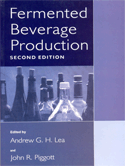
|
Fermented Beverage Production, 2nd ed. - Andrew G.H. Lea |
Author |
Andrew G.H. Lea
John R. Piggott
|
|
Cover Price : Rs 995.00
|
Imprint : Springer
ISBN : 0306477065
YOP :
|
Binding : Paperback
Total Pages : 446
CD : No
|
|
Fermented Beverage Production, Second Edition is an essential resource for any company producing or selling fermented alcoholic beverages. In addition, it will be of value to anyone needing a contemporary introduction to the science and technology of alcoholic beverages. This authoritative volume provides an up-to-date, practical overview of fermented beverage production, focusing on concepts and processes pertinent to all fermented alcoholic beverages, as well as those specific to a variety of individual beverages. The second edition features three new chapters on sparkling wines, rums, and Latin American beverages such as tequila, as well as thorough updating of information on new technologies and current scientific references.
Praise for the first edition:
"...and authoritative overview of fermented beverage production in the 1990s."
-Fruit Processing
"The essential science and technology underpinning a diversity of alcoholic beverages in presented in this splendid volume...it proves [an overview] of the (virtual) totality of fermented beverages."
-Chemistry and Industry
Contents
1. Production of Fermentable Extracts from Cereals and Fruits
2. Alcoholic Beverage Fermentations
3. Beers: Recent Technological Innovations in Brewing
4. Cidermaking
5. White Wines
6. Red Wines
7. Sparkling Wines
8. Fortilied Wines: Sherry, Port and Madeira
9. From Vine to Cognac
10. Armagnac and Wine-Spirits
11. Whiskies
12. Run
13. Vodka, Gin and Other Flavored Spirits
14. Liqueurs & Speciality Products
15. Cachaca, Pisco and Tequila
16. Filtration and Stabilization of Beers
17. Flavor Chemistry
Index
About the Authors:
Dr. Andrew G.H.Lead earned his Ph.D. for studies on the polyphenolic chemistry of apples and cider at the University of Bristol Long Ashton Research Station. He is Head of the Authenticity and Natural Products Section at Reading Scientific Services Ltd. His consultancy and analytical interests include all aspects of fruit juices and fermented beverages and the HPLC of naturally occurring plant constituents in foodstuffs. Andrew Lea is a Fellow of the Institute of Food Science and Technology.
Dr. John R. Piggott earned his Ph.D. in Food Science at Reading University. He is Reader in Food Science in the Department of Bioscience at the University of Strathclyde, Glasgow, Scotland. his research is in the flavor, quality, and acceptability of foods and beverages. He has devoted a large proportion of his efforts to alcoholic beverages, especially whisky. He has published widely in the scientific literature on sensory analysis, food flavor, and food quality. John piggott is a Fellow of the Institute of Food Science and Technology and a Chevalier of the Confrerie du Franc-Pineau.
|
|
 |
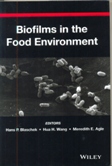
|
Biofilms in the Food Environment, Indian Reprint 2014 (EX) |
Author |
Hans P. Blaschek
Hua H. Wang
Meredith E. Agle
|
|
Cover Price : Rs 3,995.00
|
Imprint : Wiley India
ISBN : 9788126545315
YOP : 2014
|
Binding : Hardbound
Total Pages : 208
CD : No
|
|
Biofilms in the Food Environment examines biofilms produced by food-borne microorganisms, the risks associated with biofilms in the food chain, the beneficial applications of biofilms in the food environment, and approaches for biofilm removal to improve sanitation and safety in the food environment.
Specifically, this book provides:
-an introduction into the emerging and exciting field of biofilm research in the food environment
-a summary of advanced knowledge in medical microbiology and engineering and its applicability to food biofilm research, and
-potential directions for biofilm intervention and industrial beneficial applications that may have direct impact on food safety and public health.
Biofilms in the Food Environment is intended to serve as a comprehensive reference source for the food science community, including industry scientists, university researchers, and regulatory agencies. Not only are general concepts regarding biofilms in the food environment covered, but also included are in-depth reviews on biofilm structures, the correlation between strain virulence and biofilm-forming abilities, cutting-edge technologies to investigate microbial compositions in ecosystems and cell-to-cell interactions, and updated findings on molecular attributes and mechanisms involved in biofilm development that might lead to targeted approaches for biofilm prevention and removal. The topics covered and approaches discussed are truly interdisciplinary in nature.
Contents
List of Contributors.
Preface.
1. Biofilms in the food industry.
(Meredith E. Agle).
2. Shigella: Survival on produce and biofilm formation.
(Meredith E. Agle and Hans P. Blaschek).
3. Biofilm development by Listeria monocytogenes.
(Scott E. Hanna and Hua H. Wang).
4. Inactivation of Listeria monocytogenes biofilms using chemical sanitizers and heat.
(Revis A.N. Chmielewski and Joseph F. Frank).
5. Mixed culture biofilms .
(Michele Y. Manuzon and Hua H. Wang).
6. Prokaryote diversity of epithelial mucosal biofilms in the human digestive tract.
(Denis O. Krause and H. Rex Gaskins and Bryan Richardson).
7. Beneficial bacterial biofilms.
(Gregor Reid and Pirkka Kirjavainen and Bryan Richardson).
8. Applications of biofilm reactors for production of value-added products by microbial fermentation.
(Ali Demirci and Thunyarat Pongtharangkul and Anthony L. Pometto III).
Index
Hans P. Blaschek, Ph.D. is Professor of Food Microbiology and Assistant Dean of the College of Agricultural, Consumer and Environmental Sciences, University of Illinois, Urbana-Champaign, Urbana, IL.
Hua H. Wang, Ph.D. is Assistant Professor, Food Microbiology, in the Department of Food Science and Technology, Ohio State University, Columbus, OH.
Meredith E. Agle, Ph.D. is a Food Scientist in Bakery Research and Development at Rich Products, Buffalo, NY.
|
|
 |
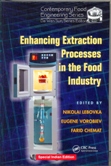
|
Enhancing Extraction Processes in the Food Industry, Indian Reprint - Nikolai Lebovka (EX) |
Author |
Nikolai Lebovka
Eugene Vorobiev
Farid Chemat
|
|
Cover Price : Rs 3,995.00
|
Imprint : CRC / Lewis
ISBN : 9781439845936
YOP : 2014
|
Binding : Hardbound
Total Pages : 570
CD : No
|
|
Extraction is an important operation in food engineering, enabling the recovery of valuable soluble components from raw materials. With increasing energy costs and environmental concerns, industry specialists are looking for improved techniques requiring less solvents and energy consumption. Enhancing Extraction Processes in the Food Industry is a comprehensive resource providing clear descriptions of the latest extraction methods and instruments used in food laboratories.
The book begins with an overview of solvent extraction technology. It examines pulsed electric fields and their effect on food engineering, and the potential and limitations of microwave-assisted extraction. It explores diffusion processes and reviews what is known about electrical discharge processes in the extraction of biocompounds.
Next, the book summarizes current knowledge on conventional and innovative techniques for the intensification of extractions from food and natural products, focusing on environmental impacts. It reviews recent developments in supercritical CO2 extraction of food and food products, describes the pressurized hot water extraction (PHWE) process, and examines future trends for PHWE. The book also examines essential oil extraction, and the tools and techniques of high pressure-assisted extraction. The authors demonstrate its application using litchi and longan fruits as examples.
The final chapters focus on extrusion-assisted extraction, gas-assisted mechanical expression, mechanochemically assisted extraction, reverse micellar extraction, and aqueous two-phase extraction. The book concludes with a chapter on the treatment of soybeans through enzyme-assisted aqueous processing, examining the economics involved as well as the development of the process.
A solid review of modern approaches that enhance extraction processes, this volume is destined to pave the way for future research and development in the field.
Content
1. Introduction to Extraction in Food Processing
2. Pulse Electric Field-Assisted Extraction
3. Microwave-Assisted Extraction
4. Ultrasonically Assisted Diffusion Processes
5. Pulsed Electrical Discharges: Principles and Application to Extraction of Biocompounds
6. Combined Extraction Techniques
7. Supercritical Fluid Extraction in Food Processing
8. Pressurized Hot Water Extraction and Processing
9. Instant Controlled Pressure Drop Technology in Plant Extraction Processes
10.High Pressure–Assisted Extraction: Method, Technique, and Application
11. Extrusion-Assisted Extraction: Alginate Extraction from Macroalgae by Extrusion Process
12. Gas-Assisted Mechanical Expression of Oilseeds
13. Mechanochemically Assisted Extraction
14. Reverse Micellar Extraction of Bioactive Compounds for Food Products
15. Aqueous Two-Phase Extraction of Enzymes for Food Processing
16. Enzyme-Assisted Aqueous Extraction of Oilseeds
|
|
 |
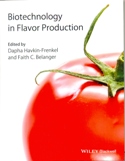
|
Biotechnology in Flavor Production - Daphna Havkin-Frenkel |
Author |
Daphna Havkin-Frenkel
Faith C. Belanger
|
|
Cover Price : Rs 4,995.00
|
Imprint : Wiley
ISBN : 9788126552047
YOP : 2015
|
Binding : Hardbound
Total Pages : 226
CD : No
|
|
Contents
1. The development of yeast strains as tools to adjust the flavor of fermented beverages to market specifications (Jan H. Swiegers, Sofie M.G. Saerens and Professor Isak S. Pretorius, The Australian Wine Research Institute, Glen Osmond, Adelaide, Australia).
2. Biotechnology of flavor production in dairy products (Dr Bart C. Weimer, Sweta Rajan, Bala Ganesan, Center for Integrated BioSystems, Department of Nutrition and Food Sciences, Utah State University, Logan, Utah, USA).
3. Biotechnological production of vanillin (Dr Daphna Havkin-Frenkel and Dr Faith C. Belanger, The Biotechnology Center for Agriculture & the Environment, School of Environmental and Biological Science, Rutgers, The State University of New Jersey, New Brunswick, New Jersey, USA).
4. Plant cell culture as a source of valuable chemicals (Dr Chee-Kok Chin.
Department of Plant Biology and Pathology, Rutgers University, New Brunswick, New Jersey, USA).
5. Tomato aroma: biochemistry and biotechnology (Rachel Davidovich-Rikanati and Yaniv Azulay, Institute of Plant Sciences, Newe Ya’ar Research Center, Agricultural Research Organization, Ramat Yishay, Israel; Yaron Sitrit.
The Jacob Blaustein Institutes for Desert Research, Ben-Gurion University of the Negev, Beer-Sheva, Israel; and Yaakov Tadmor and Dr Efraim Lewinsohn.
Institute of Plant Sciences, Newe Ya’ar Research Center, Agricultural Research Organization, Ramat Yishay, Israel).
6. Flavour development in rice (Louis M. T. Bradbury, Dr Robert J. Henry and Daniel L. E. Waters, Grain Foods CRC, Centre for Plant Conservation Genetics, Southern Cross University, Lismore, NSW 2480 Australia).
7. Breeding and biotechnology for flavor development in apple (Malus x domestica Borkh) (Dr Susan K. Brown, Department of Horticultural Sciences, Cornell University, Geneva, New York, USA).
8. Aroma as a factor in the breeding process of fresh herbs – the case of basil (Dr Nativ Dudai, Aromatic, Medicinal and Spice Crops Unit, ARO – Newe Ya`ar Research Center, Ramat Yishay, ISRAEL; and Dr Faith C. Belanger.
Department of Plant Biology and Pathology and The Biotechnology Center for Agriculture & the Environment, School of Environmental and Biological Sciences, Rutgers, The State University of New Jersey, New Brunswick, New Jersey, USA).
9. Increasing the methional content in potato through biotechnology (Rong Di, The Biotechnology Center for Agriculture & the Environment, School of Environmental and Biological Science, Rutgers, The State University of New Jersey, New Brunswick, New Jersey, USA).
10. Regulatory aspects of flavor development - traditional versus bioengineered (Dr Sabine Teske and Dr James C. Griffiths, Burdock Group, Vero Beach, Florida and Washington D.C., USA)
Dr Daphna Havkin-Frenkel, Bakto Flavors LCC, North Brunswick, New Jersey and Biotechnology Center for Agriculture and the Envirnoment, Rutgers University, New Brunswick, New Jersey, USA
Dr Faith C. Belanger, Plant Biology and Pathology Department and Biotechnology Center for Agriculture and the Environment, Rutgers University, New Brunswick, New Jersey, USA
|
|
 |
|